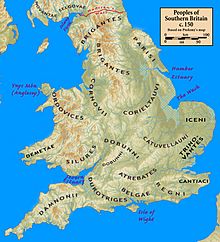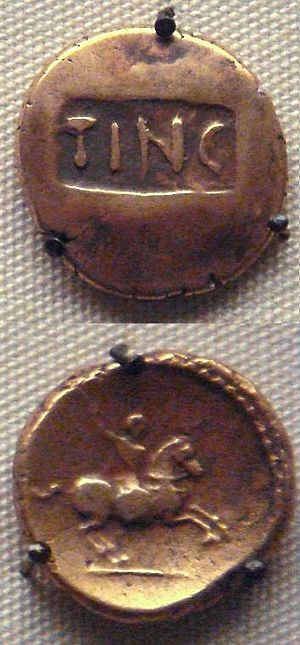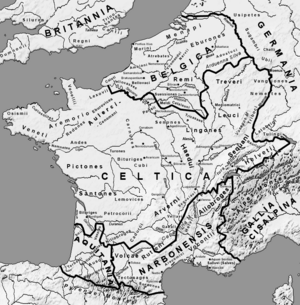Atrebates facts for kids
The Atrebates were an ancient group of people, also called a tribe, who lived during the Iron Age and the Roman period. They were part of the Belgic people and originally lived in a region now known as Artois in modern-day France. Their name, Atrebatis, meant 'dwellers' or 'land-owners'.
After the Roman leader Caesar defeated the tribes in Gallia Belgica (a part of Gaul) in 57 BC, about 4,000 Atrebates joined the Battle of Alesia in 53 BC. They were led by their chief, Commius. They rebelled again in 51 BC, but after that, they became friends with Rome. Commius was even given control over the nearby Morini people. The Atrebates were known for their good quality wool, which was mentioned in a Roman law about prices in 301 AD.
Some Atrebates likely moved to Britain before 54 BC. In Britain, they were ruled by kings like Commius, Tincommius, Eppillus, and Verica. After 43 AD, only parts of their land were still controlled by King Claudius Cogidubnus. Eventually, their lands in Britain also came under Roman rule.
Contents
What Does the Name "Atrebates" Mean?
The Atrebates were called by different names over time. Caesar and Pliny called them Atrebates. Other ancient writers like Strabo and Ptolemy used similar names.
The name Atrebates comes from a Gaulish word, *Atrebatis. This word literally means 'dwellers' or 'land-owners'. It's related to old words for 'settlement' or 'house'.
Several places today are named after the Atrebates. These include the city of Arras, the region of Artois, and the Forêt d'Arrouaise|lt=Arrouaise Forest|fr in France.
Where Did the Atrebates Live?
Their Land in Gaul
The Belgic Atrebates lived in what is now the Artois region of France. Their land was around the Scarpe river. They had two important hill forts: a large main one near Arras and another on the Escaut river at their border. The Canche river separated them from the Ambiani tribe.
Their Land in Britain
Around the mid-first century BC, some Atrebates moved to Britain. There, they lived in an area between the Thames, the Test, and West Sussex.
Their Main Towns
During the Roman period, the main town of the Atrebates in Gaul moved from Etrun to Nemetocennae, which is now Arras. This new town was on an important road. The name Nemetocennae likely meant 'sacred wood' or 'sanctuary' in the Gaulish language.
Before 54 BC, some Atrebates probably settled in Britain. After the Roman invasion of Britain, the Romans created three main administrative areas called civitates. One was for the Atrebates, with its capital at Calleva Atrebatum (modern Silchester).
History of the Atrebates
In Gaul
In 57 BC, the Atrebates joined a military alliance of Belgic tribes. They gathered 15,000 men to fight against Julius Caesar's Roman armies. Caesar saw this as a threat and marched against them. There was a standoff, and the Belgic alliance eventually broke up.
The Atrebates then teamed up with the Nervii and Viromandui tribes and attacked Caesar at the battle of the Sabis. However, they were defeated. After conquering the Atrebates, Caesar made one of their own, Commius, their king. Commius helped Caesar during his two trips to Britain in 55 and 54 BC. He also helped negotiate the surrender of a British chief named Cassivellaunus. Because of his loyalty, Commius was given control over the Morini people.
However, Commius later turned against the Romans. He joined the big revolt led by Vercingetorix in 52 BC. After Vercingetorix was defeated at the Siege of Alesia, Commius continued to fight the Romans. He eventually made a peace deal with Mark Antony and fled to Britain with some of his followers. Even so, he seemed to keep some power in Gaul, as coins with his name were found there.
In Britain
Quick facts for kids Atrebates |
|
 |
|
| Geography | |
| Capital | Calleva Atrebatum (Silchester) |
|---|---|
| Location | Hampshire West Sussex Berkshire |
| Rulers | Commius Tincomarus, Eppillus, Verica |
Commius soon became king of the British Atrebates. He might have even founded their kingdom there. Their land in Britain included parts of modern Hampshire, West Sussex, and Berkshire. Their capital city was Calleva Atrebatum (modern Silchester). To the north, they bordered the Dobunni and Catuvellauni tribes. To the east were the Regni, and to the south were the Belgae.
The Atrebates' arrival in Britain was not a huge movement of people. Experts believe they were mostly local tribes who were united by Commius. It's possible that "Atrebates" referred more to the ruling family than to a specific ethnic group. Commius and his followers may have built their power and slowly expanded their influence, creating a kind of early state. However, during Caesar's first trip to Britain, Commius was able to provide horsemen from his people. This suggests he might have already had family or connections in Britain at that time. After this, the Atrebates became a client kingdom of Rome, meaning they were friendly with Rome and followed its lead.
Coins with Commius's name were made in Calleva from about 30 BC to 20 BC. Some coins say "COM COMMIOS," which might mean "Commius son of Commius." This makes some people think there were two kings with the same name, a father and a son.
Three later kings of the British Atrebates also put their names on coins and said they were sons of Commius: Tincomarus, Eppillus, and Verica. Tincomarus seems to have ruled with his father from about 25 BC until Commius died around 20 BC. After that, Tincomarus ruled the northern part of the kingdom from Calleva. Eppillus ruled the southern part from Noviomagus (Chichester).

Coins and other findings suggest that Tincomarus was more friendly towards Rome than his father. Some historians believe he might have grown up in Rome as a diplomatic guest.
The Roman emperor Augustus mentioned two British kings who came to him for help around 7 AD. One of them was probably Tincomarus. It seems Tincomarus was removed from power by his brother. After this, Eppillus's coins were marked "Rex" (King), showing that Rome recognized him as king.
Around 15 AD, Verica took over from Eppillus. At the same time, another king named Eppillus appeared as ruler of the Cantiaci in Kent. But Verica's kingdom was being pressured by the growing power of the Catuvellauni tribe, led by Cunobelinus. Calleva fell to Cunobelinus's brother, Epaticcus, around 25 AD. Verica got some land back after Epaticcus died around 35 AD. However, Cunobelinus's son Caratacus continued the fight. By the early 40s AD, the Atrebates were completely conquered. Verica fled to Rome, which gave the new emperor Claudius a reason to launch the Roman conquest of Britain.
After the Roman conquest, some of the Atrebates' lands became a pro-Roman kingdom ruled by Tiberius Claudius Cogidubnus of the Regni tribe. He might have been Verica's son. Later, the tribal lands were organized into Roman administrative districts for the Atrebates, Regni, and possibly the Belgae.
It's important to remember that the Atrebates in Britain might have been more of a ruling family or dynasty than a large group of people who moved from Belgium to Britain.
Who Were the Kings of the Atrebates?
- Commius, 57 - c. 20 BC
- Tincomarus, c. 20 BC - AD 7, son of Commius
- Eppillus, AD 8 - 15, brother of Tincomarus
- Verica, 15 - 40, brother of Eppillus
- Claudius Cogidubnus
- Full Roman control began after this.
See Also
- List of Celtic tribes
- List of peoples of Gaul
- Celtic tribes in the British Isles


